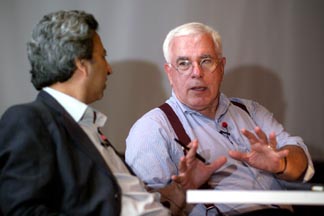Peter Eisenman predicts tomorrow's architects will move beyond barriers of time, space and function
By Linda Myers

The terrorist-manned planes that destroyed the World Trade Center on Sept. 11, 2001, marked "the end of the age of spectacle," and of the passive spectator, according to renowned architect Peter Eisenman '54, B.Arch. '55.
Looking energetic and vigorous at 73, he discussed why "Architecture Matters" before an audience that filled Kennedy Hall's Call auditorium Sept. 13. The talk was the first in the College of Architecture, Art and Planning (AAP) 2005-06 dean's lecture series.
Eisenman began by explaining why the televised images of the attacks marked the end of the postmodern era for him. "It was an unscripted, unplanned reality show [that has prompted architects] to rethink the role of place and what it means to be somewhere," he said. "Being there" is the only thing that architecture can still do that media images cannot usurp, said Eisenman, who witnessed the smoke and fire from a window in his lower Manhattan office.
He also said that, for the terrorists, the attacks were less about shutting down a center where international trade took place than about demolishing a building symbolizing an old social order.
While the event was unique, the "paradigm shift" that followed is one of many such shifts recurring throughout history, each with far-reaching consequences for society and for architecture, according to Eisenman. Among the events he cited that displaced old orders and ushered in new ones were the storming of the Bastille in 1789, the bombing of Hiroshima and the liberation of Auschwitz at the end of World War II, and the riots in U.S. ghettos in 1967-68.
In architecture, paradigm shifts occurred following Le Corbusier's concept for the Maison-Domino -- a basic building type, with free-standing pillars and rigid floors, that could be mass produced -- which signaled the beginning of modernism in 1914; and the publication of influential philosophical texts, such as Jacques Derrida's "De la grammotologie" and Guy Debord's "The Society of the Spectacle," which heralded the entry of postmodernism, Eisenman said.
The trouble with postmodern architecture, Eisenman said, was, "It represented an idea of change ex nihilo, for its own sake, but was not able to propose a social critique" because it did not have the language to inspire change. "In previous periods, modern architecture proposed not only a social and political critique but a critique of existing language. We need a new language," said Eisenman, suggesting that, for architects, "language" is as much about form and matter as about words.
He lambasted such contemporary architectural phenomena as gated communities for turning their back on society's problems. He stated: "The new urbanism is really an old urbanism, giving in to market forces. When is the last time the federal government asked a good architect to work on a socially provocative housing project?" And he called much of the work of today's architects, such as perfume bottles for Prada, "a glorified fashion show with nothing to do with architecture and its relationship with the social order.
"When leading architects produce work that is "an internal architectural critique married to a social critique, we'll have the beginning of a new paradigm," he said.
He praised some of the work of architect Rem Koolhaas, however, for its fresh approach, which rejects "the Cartesian dimension and disjuncts space and time and function. [Space] doesn't have to be contiguous and flat. Can't it be bumpy, like a sausage that has eaten a pig?" And he complimented Frank Gehry for stating, through his creations, that "buildings no longer have to have four walls. This is an important notion in terms of the paradigm shift from the mechanical to the electronic."
Eisenman also presented slides of one of his own most-recent works, the Berlin Memorial to the Murdered Jews of Europe. The thousands of concrete pillars and wood blocks that make up the memorial are so close to each other that only one person can pass between them at a time, and it is as easy to get lost among them as in a cornfield -- one of the work's inspirations. To visitors who ask, "Where is the center, where are the inscriptions?" (there are neither), he counsels: "Architecture is not about information -- we're saturated with information. The field of pillars is a memory of the unrecordable, unmemorable, unmarkable." To critics of the memorial, he explained, "I was attempting silence."
Eisenman was welcomed by AAP Dean Mohsen Mostafavi, who praised him for combining theory, art and practice successfully for decades and said that his work demonstrates he is still at the forefront of his field.
"I cannot be an enfant terrible at age 73; it doesn't fit," replied Eisenman. "I've been on the stage too long. The next paradigm shift will elude me," but the new generation of architects is likely to spot it, he said. "My role is to pass on to students that possibility."
Media Contact
Get Cornell news delivered right to your inbox.
Subscribe